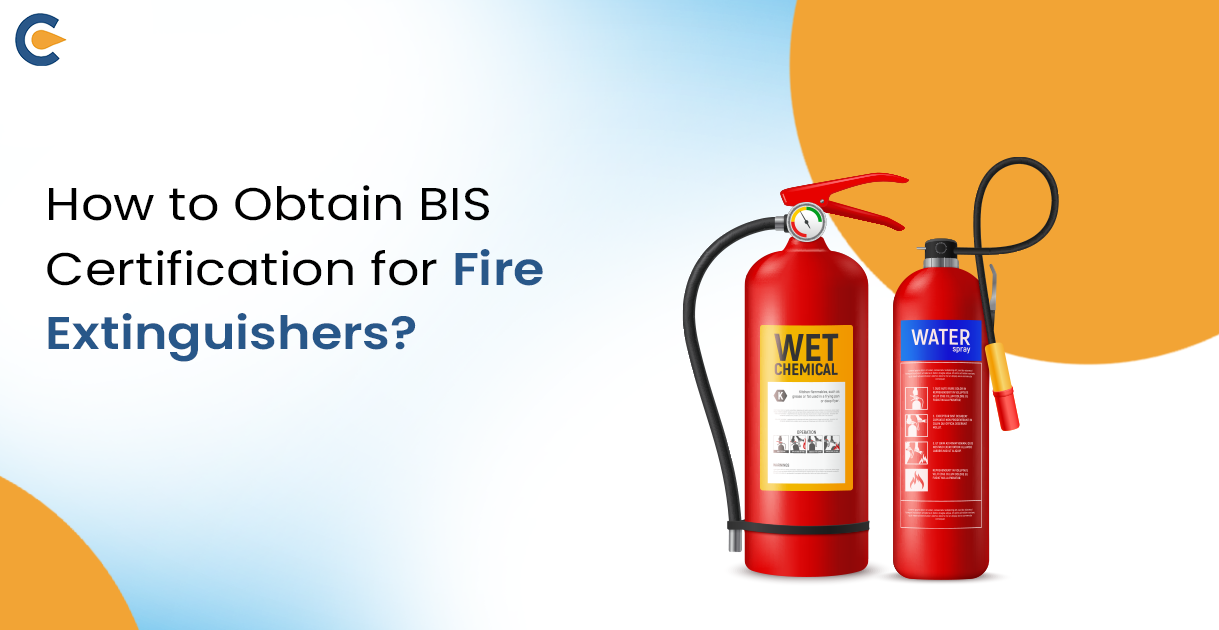BIS Standards for fire-fighting equipment mainly refers to Fire extinguishers, as they are the most crucial product when there is a fire hazard. They are portable and handy and help protect lives and prevent sizeable damage to property that can otherwise be caused by fires. Therefore, to assess the quality of this life-saving equipment, there is a very strict compliance requirement as mandated by the Bureau of Indian Standards (BIS) on manufacturers of these fire extinguishers.
BIS certification for fire extinguishers would not only make the device fit for sale in the market technically but also instil faith in consumers, because a BIS certification for fire extinguishers is a mark of standard product quality and sturdiness approved by the government. If you own a fire extinguisher manufacturing business, a retailer or fire-safety equipment, or even a consumer/corporation with fire extinguishers installed in their premises, knowing the market standards for commercial fire extinguishers is very important in compliance.
Types of Fire Extinguisher in India
Commercial-grade fire extinguishers in India are manufactured based on their size, shape, fire-dousing material, and IS standard set by BIS. The Government of India passed the Fire Extinguishers (Quality Control) order, 2023, for the purpose of specific IS standards for Portable and Wheeled fire Extinguishers. To obtain BIS Certification for fire extinguishers, based on fire-dousing material, types of fire extinguishers in India are divided into two broad categories –
- Portable Fire Extinguishers
These types of fire extinguishers are compact, lightweight, and can be placed anywhere easily. Portable fire extinguishers are mostly placed in public places, such as hotels, trains, restaurants, etc. They are characterized by their lightweight and easy operability. As per the applicable ISI Standard – IS 15683:2018, portable fire extinguishers should not weigh more than 17 kg. Also, such portable fire extinguishers should be made so that they can be operated by two persons and used immediately.
- Wheeled Fire Extinguishers
This is a category of larger, more voluminous categories of fire extinguishers that are required to be wheedled outon mini-trolleys to be used at the incident site. As per ISI standard IS 16018:2012, the total weight of a wheeled fire extinguisher should range between 17 lakhs and 450ks, including the mass of all other equipment and accessories. Based on the types of fire-dousing material filled inside the fire extinguishers, the wheeled fire extinguishers are further divided into the following categories –
- Water – Based Fire Extinguishers
They are water-based fire extinguishers that remove the fire by applying Air-Pressurized Water (APW) on the fire site. These kinds of fire extinguishers douse fire by cooling the source of heat and are the most commonly used; however, they should not be used in events where the fire has been caused by electricity or petroleum.
- Dry Powder-based Extinguishers
These kinds of extinguishers propel a dry powder made of Mono Ammonium Phosphate and create a blanket around the fire, eventually cutting oxygen off its fuel and dousing the fire. These types of fire extinguishers are suitable for almost all types of fire since they do not mix with the source and engulf it completely. Also, Mono Ammonium Phosphate coats the extinguished place with a non-inflammable substance, which prevents fire from re-igniting
- Co2- based fire extinguishers
Also known as dry ice, Carbon dioxide douses the fire by acting as a counter agent. The CO2. Co2 gushes out of the barrel like a jet spray, causing a cooling effect on the fire and putting it out instantly. Unlike dry powder, Co2 also leaves no residue on the extinguished surface.
- Water Sprinkler
This is a very efficient system of fire prevention and control. They are also known as self-activating fire extinguishers since they become automatically active when fire comes in touch with them. They are in the shape of balls or tops and fitted on the room’s ceiling. The pipeline system underneath them contains water or dry ice, and upon activation, they spray a large amount of the water gas on the fire’s spot, suppressing it. Fire sprinklers are an extremely effective fire suppression system useful when the premises are spread over a large, unattended area such as hotels, power stations, warehouses, etc.
Categories of Fires
Based on intensity, fire is classified into five alphabetical categories- A, B, C, D, F. While issuing BIS Certification for Fire Extinguishers, the Bureau can also classify which type of fire extinguisher has to be used in which category of fire. –
Category A
These fires are caused by combustible objects such as wood, paper, plastics, etc.
Category B
The main root of these types of fires is inflammable objects, such as petrol, oil, diesel, etc.
Category C
These include fires caused by high-pressure inflammable gases such as LPG and CNG.
Category D
These fires are caused by the inflammation of highly combustible minerals and elements such as sodium, potassium, aluminium, etc.
Category F
These fires are caused due to home appliances and edibles such as oil, fat, LPG gas, etc. These are known as Kitchen Fires.
Why does BIS Certification for Fire Extinguishers matter?
BIS Certification for Fire Extinguishers is a very important and crucial industrial compliance that safeguards human safety and social security of industrial and manufacturing units. Without standardization of fire safety equipment, almost all residential and commercial spaces would face a threat of fire spread. BIS certification for fire extinguishers plays an important role in the sphere of hazard safety in the following ways-
- Assurance of Quality
Portable Fire extinguishers that satisfy the IS15683:2018 and wheeled fire extinguishers that satisfy the standard IS 16018:2012 are considered to be very reliable qualitatively and would not malfunction or default at the time of need.
- Classification on the basis of fire
The IS standard not only classifies the fire extinguishers but also puts the category fire of fire with the type of extinguisher that would be compatible with dousing that kind of fire. Therefore, BIS certification for fire extinguishers is a very helpful benchmark that can be used to make classifications with respect to fire and extinguisher types.
- Compliance with safety regulations
BIS certification for fire extinguishers is used as a reference by regulatory authority inspectors and fire departments to assess the fire-hazard readiness of the premises. Also, BIS certification for fire extinguishers is a necessary document required by the authorities while issuing a Fire NOC.
- Labelling and marking requirements
BIS also lays down guidelines for labelling and marking important instructions on the cylinder of the fire extinguisher. Labels like instructions for use, chemical composition, and fire hazard labels are all necessary requirements as per the standards. The approval of BIS certification for fire extinguishers is contingent on the fulfilment of these labelling requirements.
Fire Extinguishers (Quality Control) Order, 2023
The Ministry of Trade and Commerce in 2023 passed the Fire Extinguishers (Quality Control) order as a directive to streamline the Fire safety standards in India along with the guidelines of the Bureau. As per the order, the fire extinguisher manufacturers are required to comply with the labelling requirements set out in the Table given in the statute. The statute states that both categories of fire extinguishers, i.e. portable and wheeled fire extinguishers, are required to bear the ISI Mark under a license from the Bureau of Indian Standards. The order mandated the display of respective ISI marks, i.e. IS 15683:2018 for portable and IS 16018:2012 for wheeled fire extinguishers, on BIS-certified fire extinguishers. Any manufacturer found to be in contravention of the rules shall be punishable as per the provisions of Bureau of Indian Standards Act, 2016.
Process for applying for a BIS Certification for Fire Extinguishers
The Process for applying for a BIS Certification for Fire Extinguishers involves a step-by-step procedure including making an application with the Bureau at one of its regional office, followed by examination by the Bureau officials, inspection, scrutiny of fire-dousing material, and final approval/rejection. The process is as follows-
Step 1: Application submission
To obtain a BIS Certification for Fire Extinguishers, the applicant must apply with the nearest BIS branch office in the prescribed form.
Step 2: Examination and Review
After submitting the application, the BIS officials carefully examine and verify the document submitted with the application. They scrutinize the technical documents such as test reports, product specifications, labelling and markings, details of the manufacturers, etc., in order to ensure that the details comply with fire safety standards in India, such as ISI standards- IS15683:2018 and IS 16018:2012.
Step 3: Inspection
After being satisfied with the details of the documents, the officials conduct a survey of the manufacturing plant or production unit of the applicant in order to inspect the production unit and the processes of fire extinguisher manufacturing put in place by the applicant.
Step 4: Collection of Samples
The BIS officials collect samples of the fire extinguishers and the material used for dousing fire. They conduct tests on the samples to verify whether they meet the required performance levels set by the standards.
Step 5: Testing of samples
The Officials conduct tests of the sample, including discharge tests, pressure leakage compression tests, etc., as per BIS standards and guidelines. For the purpose of obtaining a Material Test Certificate (MTC), the applicant is required to have the fire-dousing material tested from a BIS -BIS-accredited laboratory and include the test reports in the application form.
Step 6: Evaluation of submission
After conducting all necessary tests, the BIS Officials make a final evaluation of sample tests, test reports, and the documents provided by the applicant in order to make a final evaluation of the application made for obtaining a BIS certificate for fire extinguishers.
Step 7: Approval of application
If the application for BIS Certification for fire extinguishers meets all the requirements and standards as laid down by the BIS, in consonance with the fire safety standards in India, the Bureau officials approve the application, and a BIS license is granted to the applicant.
Documents required for the purpose of making an application for BIS Certification for fire extinguishers
To make an application for BIS certification for fire extinguishers, the following documents are required to be submitted to the regional office of BIS by the applicant-
- Application form in Form V.
- Clearance certificate of fire-dousing material as per ISI Standard.
- Lab test report from an accredited laboratory.
- Details about manufacturing processes.
- Address and ownership proof of the manufacturing unit.
- Personal details of the Applicant – AADHAR, PAN, expression of interest.
- Details of the business – AOA, CIN, DIN, address of registered office.
- Material Test Certificate (MTC) from a BIS-accredited laboratory.
Conclusion
Fire extinguishers are the most important fire-safety equipment in any commercial or private premises. The BIS Certification for fire extinguishers is a necessary safety compliance requirement required to be adhered to by the manufacturers of fire extinguishers in order to uphold fire safety standards in India. The Bureau of Indian Standards has mandated strict compliance with quality standards for the manufacturers and sellers of fire extinguishers, and non-compliance would lead to severe penalties.
If you are looking for a trusted and reliable compliance consultant to look after the complexities of your business, then no need to look further. Corpbiz provides you with an all–in–one solution for your business at the most competitive prices in the market. Our dedicated and experienced professional team of CA, CS, and Lawyers would ensure that every minor compliance requirement is discharged with efficiency and in a time-bound manner. Our strategic services ensure that our clients do not have to worry about their routine regulatory compliance compliances and can focus on their business activities.
Frequently Asked Questions (FAQs)
The Bureau of Indian Standards (BIS) is the national standardization and accreditation body that examines, grades, and certifies the quality of consumer products as well as sets industrial standards for manufacturers and producers of consumer goods and services.
The Bureau of Indian Standards was established as the National Standards Body of India on 23rd December 2023 and operates within the Ministry of Consumer Affairs, Food and Public Distribution.
The ISI Mark is a standard mark for the quality of a product issued by the BIS. It is also known as a BIS mark.
BIS has approved two major categories of Fire Extinguishers –
1. Portable Fire Extinguishers
2. Wheeled Fire Extinguishers
Based on the type of fire-fighting material inside, fire extinguishers are divided into the following categories –
1. Dry-Powder based extinguisher
2. Foam based extinguisher
3. Co2 (dry ice) based extinguisher
4. Water Sprinklers
As set by the BIS, the IS Standards for portable fire extinguishers is IS 15683:2018, and for wheelable fire extinguishers, IS 16018:2012.
BIS has classified fire hazards, based on their intensity, into five categories – A, B, C, D, E, and F.
As per the Fire Extinguishers (Quality Control) Order, 2023, the manufacturers of fire extinguishers are required to adhere to labelling and marking requirements, whereby the IS standard and important markings are supposed to be clearly visible on the Fire extinguisher cylinder.
For the purpose of making an application for obtaining a BIS certificate for fire extinguishers, the applicant has to submit and application to the authorities and then the concerned authorities will examine and review the application. Moreover, the samples of the products will be collected and tested in the laboratory. Therefore, after evaluating the documents and samples collected, the application will be approved, and BIS certification will be granted.
Documents such as Application form in Form V, clearance certificate of fire-dousing material as per ISI Standard, Lab test report, details about manufacturing processes, Address and Ownership prod of the manufacturing unit, AADHAR, PAN of the applicant, AOA, CIN, DIN, address of registered office and Material Test Certificate (MTC) from a BIS-accredited laboratory are required for making an application for obtaining a BIS Certificate .
Based on the category of certification, the BIS certification for fire extinguishers takes about 120 days or about four months to complete.
The average cost of obtaining a BIS certification for fire extinguishers is Rs. 1000 as application fees, plus Rs. 25,000 as processing fees against one test report.
The BIS Certification for fire extinguishers remains valid for a period of 2 years, after which it can be renewed by making a re-application.
Fulfilling statutory compliances and requirements of the BIS requires meticulous due diligence and adherence to regulatory controls. At Corpbiz, we provide extensive compliance management services and ensure statutory compliance is met to check all the boxes required to apply for a BIS certification for fire extinguishers. We are the best legal and compliance management and corporate advisory services providers out there, supporting you at every step.
Yes, the BIS mark is an internationally recognized mark that represents the credibility of the water purifying system at par with global quality standards and consumer requirements. BIS-certificated products can be easily exported and sold in other countries.
Read Our Article: Importance Of BIS Certification For Brand?













